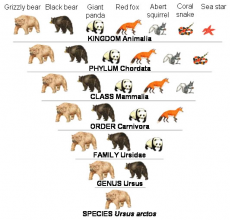

What is classification in biology? The act of organising organisms into categories based on similarities and differences, taking into account the way something looks, its genes, its behaviour and more. Grouping organisms make it easier to identify new organisms and find out more about them. They can then be placed onto a taxonomic hierarchy. A taxonomic hierarchy has eight levels, the one you are probably most familiar with is ‘species.’ A species is a group of living organisms consisting of similar individuals capable of exchanging genes or interbreeding. The levels begin with domains, followed by kingdom, phylum, class, order, family, genus and lastly species. If two organisms are in the same eight groups they are the same species and are extremely similar. If two organisms were in seven of the same groups with a different species, they are said to be very similar and related, but there was a point in evolutionary history where the two diverged and became slightly different. As you move down the hierarchy, there are more groups but fewer organisms in each group.
There are three options for domains, Eukarya, Archaea and Bacteria. All animals and plants are Eukarya, where we are multicellular organisms. Archaea and Bacteria are single-celled or unicellular organisms. Before the three-domain system was used, the first type of classification was the five-kingdom classification system. It focused on general characteristics to classify organisms. The kingdoms are Prokaryotae, Protoctista, Fungi, Plantae, Animalia.
Kingdom and examples
Prokaryotae- Bacteria
Protoctista- algae, protozoa
Fungi- moulds, yeasts, mushrooms
Plantae- mosses, ferns, flowering plants
Animalia- nematodes, molluscs, insects, fish, reptiles, birds, mammals
Prokaryotes are unicellular organisms which do not have a nucleus (an important key feature making them highly distinguishable under a microscope.) Protoctista are eukaryotic cells that usually live in water, like the Protoctista which cause malaria. Plasmodium (the causative agent of malaria) is present in the water where mosquitoes complete their breeding cycle, the mosquitoes become carriers and can cause the spread of malaria. Protoctista can be single-celled or multicellular organisms. Fungi are eukaryotic organisms that are saprotrophic (they absorb substances from dead or decaying organisms). They can be single-celled or multicellular with a chitin cell wall. The chitin cell wall makes them highly distinguishable from other organisms. Plantae are eukaryotic multicellular organisms with cell walls made from cellulose. Plant cells can photosynthesise making them autotrophic. Autotrophic means that the plants can make their own food (plants make glucose and then other carbon compounds through photosynthesis and then carbon synthesis.) The plants must contain chlorophyll to photosynthesise. The cell wall is a key feature which makes plant cells distinguishable from animal cells. Animalia are eukaryotic organisms that are also multicellular. Animalia are heterotrophs as we they cannot make their own food and therefore consume other animals and plants to survive. Animalia cells do not have cell walls, just a membrane. Us humans all come under the kingdom Animalia as we are mammals. Multicellular organisms are highly complex and require vast investigation. Doing so can help us to understand features about ourselves that we probably never even considered!
Image- http://www.goldiesroom.org/Note%20Packets/02%20Classification/00%20Classification%20Packet--WHOLE.htm

0 Comment:
Be the first one to comment on this article.